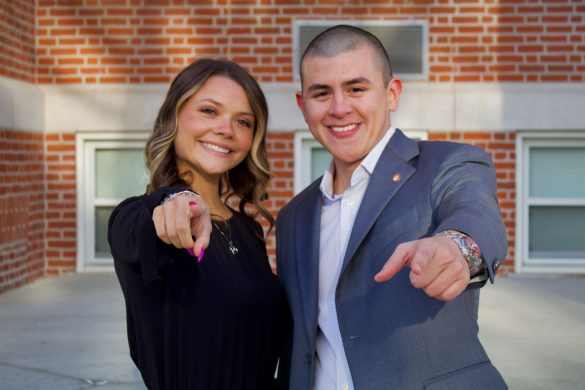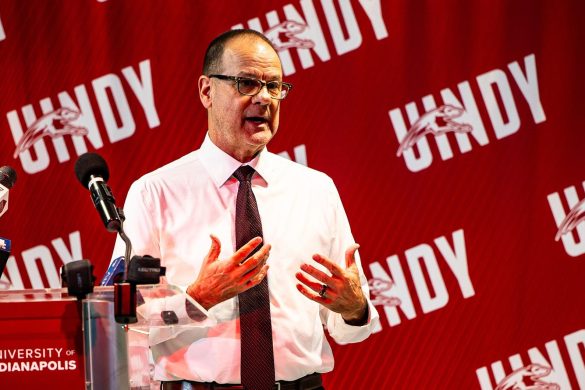Every year, Black History Month gives the University of Indianapolis the opportunity to educate and reflect. While the university has “from its beginning… been coeducational and open to all races,” according to the UIndy website, that does not mean that all students have always felt welcomed. The university’s archives give a peek into a complicated past at UIndy while also serving as time capsules for the culture around race relations at the time.
Black history has been celebrated on the UIndy campus for many years. As seen on the front page of the Feb. 24, 1977 issue of The Reflector, before Black History Month, there was Black History Week. According to History.com, “By the late 1960s… ‘Negro History Week’ had evolved into Black History Month on many college campuses.” In 1976, United States President Gerald Ford officially recognized Black History Month. Every U.S. president since has recognized February as Black History Month.
This year, UIndy is celebrating Black History Month with multiple events throughout the month, including “Talk Tuesdays” on topics such as identity and inclusivity and a “Black Excellence Dinner.” These events and more were announced in an email from Vice President of Student Experience, Success and Belonging Amber Smith.
The aforementioned Reflector front page features coverage of a Black History Week event on campus, in which the former mayor of Gary, Ind., Richard Hatcher, was a guest speaker. Hatcher was the first African American mayor of Gary, where he served for 20 years from 1968 to 1988, according to blackpast.org. The article summarizes topics covered by Hatcher at the event, including the recent election of President James Carter and the controversy surrounding the ABC miniseries “Roots.”
Three years later in the Feb. 14, 1980 issue of The Reflector, it was reported that an exhibit was opened in the Krannert Memorial Library for Black History Week. The exhibit was titled “The Black Family, Invisible Sinew” and featured collectibles that belonged to Black Indianapolis families. The article also mentions upcoming musical events and programs that were presented by Black students.
By the 1990s, the university was celebrating Black History Month instead of Black History Week. The Feb. 2, 1998 issue of The ECE Ladder, a UIndy newsletter, featured a write-up of the importance of Black History Month and the events happening on campus. The university celebrated that year with Lecture/Performance series events. The article also shares “excellent World-Wide Web sites that feature Black History.”
Although these articles throughout the decades show that the university openly celebrated Black History Month and welcomed Black speakers on campus, there are also plenty of articles documenting Black students continuing to struggle with racism. In an article printed in the Oct. 5, 1993 issue of The Reflector, a student wrote a letter to the editor sharing an incident in which he and his friends were refused service and treated unfairly at a restaurant near campus. In the next four issues, fellow students wrote back to him accusing him of being racist himself and stereotyping white people as racists. The student continued to write about his experiences with racism and his belief in holding others accountable.
The Feb. 21, 2007 issue of The Reflector includes an article titled “From Discrimination to Diversity” by Katy Yeiser, the editor-in-chief at the time of its publication. The article discussed both the hardships and achievements of Black and
African American students throughout UIndy’s history. Yeiser said that the university’s first Black students were there as a result of missionaries associated with the university, including the first editor-in-chief of The Reflector, David Manley, who came to the university in 1919. UIndy President I.J. Good said in the preface of Manley’s university biography: “Therefore, let us know more of the condition of our neighbors in the dark lands and we will the more eagerly help to train those who will take the light.”
Additionally, Yeiser reported that illustrations in the 1917 yearbook and a 1927 comedy skit promoted in The Reflector both featured derogatory characterizations of African Americans. In the 1930s, President Good advised Black
students to not attend social activities on campus after they showed up to support Bud Smith, the first African-American to play on the football team, according to Yeiser.
“The university’s African American history is one of intolerance, bigotry and progress—accented by the African-American students who overcame discrimination to shape UIndy,” Yeiser said. This sentence still rings true in 2023. UIndy’s 12% Black or African American population continues to face instances of racism, but also exhibit excellence both on and off campus.








